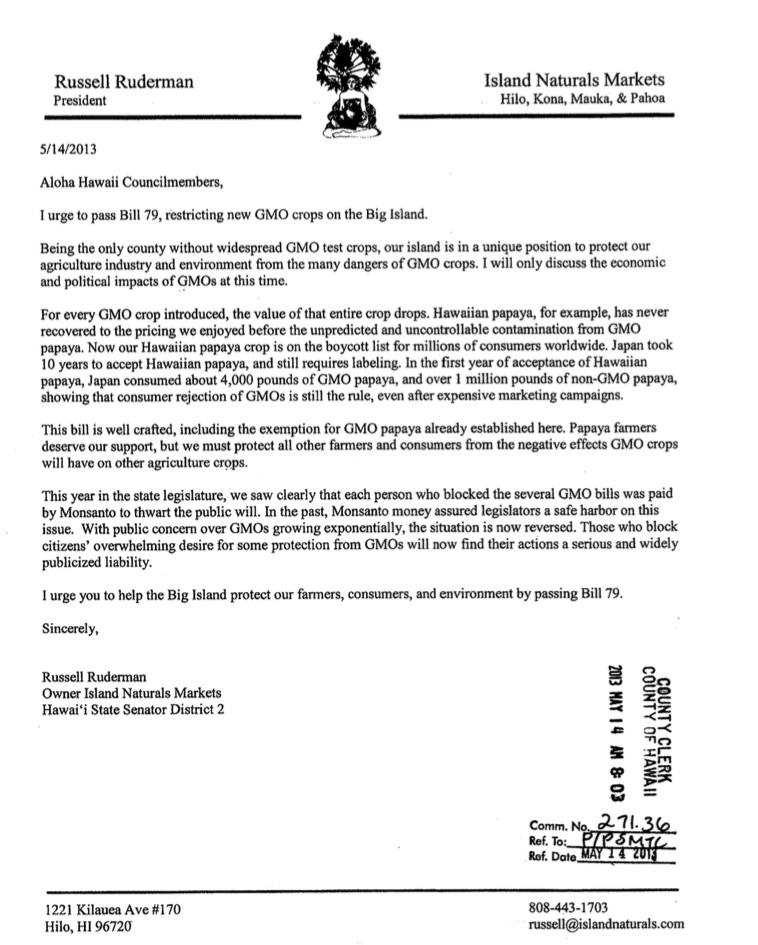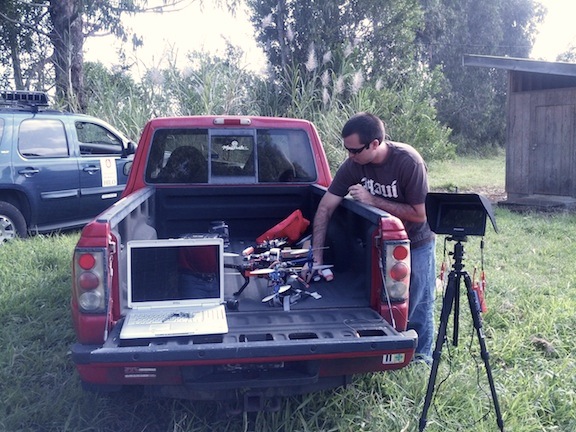Richard Ha writes:
The New York Times just ran an excellent, balanced and well-received article on Hawai‘i Island’s recent GMO ban. It was written by Amy Harmon, a national correspondent for the Times who covers the impact of science and technology on American life. She’s won two Pulitzer Prizes for her work.
A Lonely Quest for Facts on Genetically Modified Crops
By AMY HARMON
KONA, Hawaii — From the moment the bill to ban genetically engineered crops on the island of Hawaii was introduced in May 2013, it garnered more vocal support than any the County Council here had ever considered, even the perennially popular bids to decriminalize marijuana.
Public hearings were dominated by recitations of the ills often attributed to genetically modified organisms, or G.M.O.s: cancer in rats, a rise in childhood allergies, out-of-control superweeds, genetic contamination, overuse of pesticides, the disappearance of butterflies and bees.
Like some others on the nine-member Council, Greggor Ilagan was not even sure at the outset of the debate exactly what genetically modified organisms were: living things whose DNA has been altered, often with the addition of a gene from a distant species, to produce a desired trait. But he could see why almost all of his colleagues had been persuaded of the virtue of turning the island into what the bill’s proponents called a “G.M.O.-free oasis.”
“You just type ‘G.M.O.’ and everything you see is negative,” he told his staff. Opposing the ban also seemed likely to ruin anyone’s re-election prospects.
Yet doubts nagged at the councilman, who was serving his first two-year term. The island’s papaya farmers said that an engineered variety had saved their fruit from a devastating disease. A study reporting that a diet of G.M.O. corn caused tumors in rats, mentioned often by the ban’s supporters, turned out to have been thoroughly debunked.
And University of Hawaii biologists urged the Council to consider the global scientific consensus, which holds that existing genetically engineered crops are no riskier than others, and have provided some tangible benefits.
“Are we going to just ignore them?” Mr. Ilagan wondered.
Urged on by Margaret Wille, the ban’s sponsor, who spoke passionately of the need to “act before it’s too late,” the Council declined to form a task force to look into such questions before its November vote. But Mr. Ilagan, 27, sought answers on his own. In the process, he found himself, like so many public and business leaders worldwide, wrestling with a subject in which popular beliefs often do not reflect scientific evidence…. Read the rest
Hawai‘i County Councilperson Margaret Wille, though, refers to this article as “Hogwash!”
She’s the local councilperson who spearheaded the Big Island biotech ban, and her comment on the New York Times article kind of says it all. In her second-to-last paragraph she lumps farmers in with “GMO apologists,” which makes us the enemy. We are not the enemy.
Her comment follows the New York Times article:
Margaret Wille
Hawaii Island Hawaii
The underlying message in this article is that pro-GMO is pro-science and those opposed are anti-science. Hogwash! It is the biotech corporations that politically obtained the USDA “political” exemption from being required to do premarketing health and safety tests. This political decision was based on the claim that GMO crops are “substantially equivalent” to the corresponding non-GMO crops. Instead of government required health and safety testing, uncontrolled “open field” testing is occurring right here in Hawaii on Kauai– where all the evidence points to immune disruption of the young and unborn , as well as harm to the soil and adjacent aquatic life.. At the same time these same corporations obtain patent rights based on the distinction of their GMOs, allowing the intellectual property laws to function as the barrier to obtaining the information independent scientist needed to do long term studies.
And whenever an independent study is underway, the GMO offensive position is to discredit the scientist or buy out the organization, as occurred in the case of the international organization doing studies on the adverse affects of associated pesticides on bee populations.
The bottom line is that we passed Bill 113 despite all the opposition from Big Ag GMO proponents and their on island mouthpieces.
Hopefully in the future, the New York Times will curb its biased approach to coverage of GMO related issues.
Contrast Councilperson Wille with Councilperson Ilagan. What a difference.
At this point, it’s really not a matter of who can yell the loudest, but of sitting down and deciding where we want to end up, and how we’re going to get there. We have a very serious food security issue (I’ll be writing more about this next time) that, with our Peak Oil situation, is only likely to get worse.
We are not looking at a First Amendment situation here, where everyone’s opinion matters. Everyone is welcome to his or her opinion, but at this point, when it comes to making important policy for our people and our food security, we need to sit down and form the best policy we can, using the best science.
What was not covered in the New York Times article was Big Island farmers’ concern that the ban on biotech solutions only applies to Big Island farmers, and not their competitors on other islands or on the mainland.
The president of the Hawaii Papaya Industry Association asked why only papaya farmers are beng required to register their crops and pesticide usage. He said that papaya farmers feel like they are being treated like sex offenders.
And why is there a blanket ban on open air testing? With bananas, flying pollen makes no difference, because they don’t have seeds.
Fusarium wilt killed off the mai‘a maoli as well as the mai‘a popoulu, two banana plants that came to Hawai‘i on the canoes. What if we could bring them back?
What if a virus threatens to kill off all our taro? Would we want to be able to try and save it? What would the ancient ones do?



